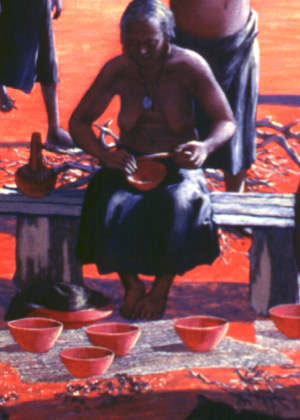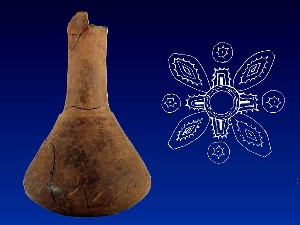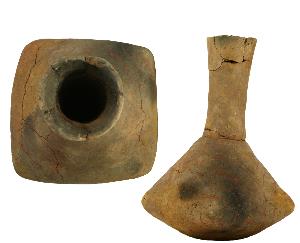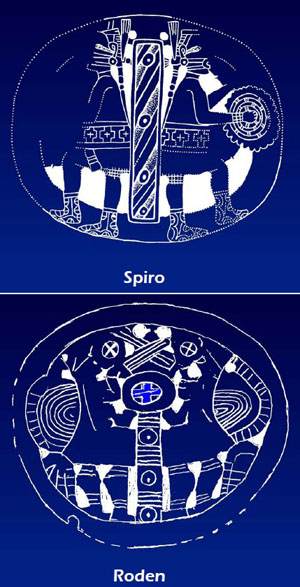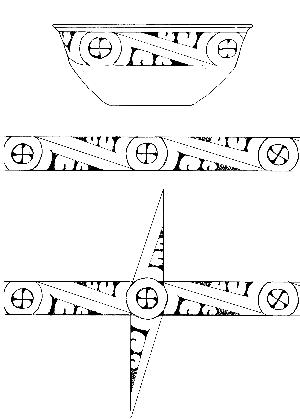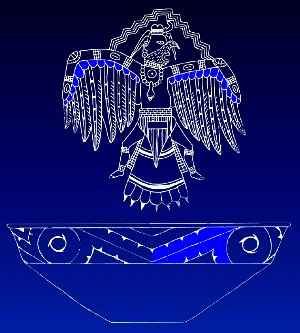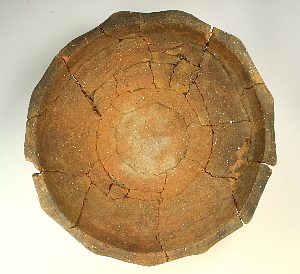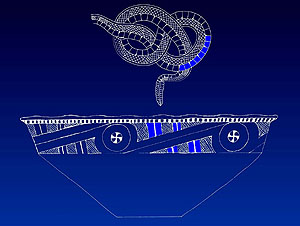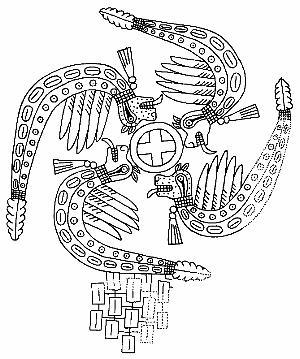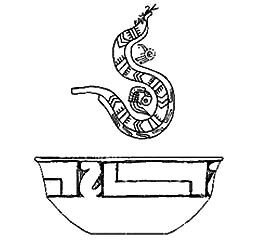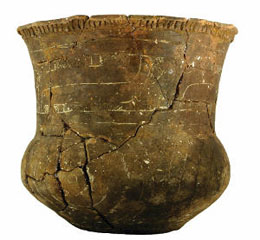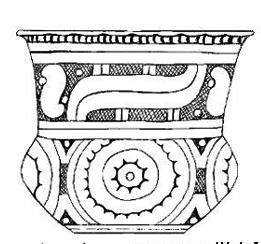Ceramic Vessels of the Nadaco Caddo and their Links to Mississippian Iconography
| Ripley Engraved bowls and bottles with varied motifs from the Pine Tree Mound site. The main decorated ceramic type found at the site, the vessels are well suited for iconographic study. They make their appearance during the time when exotic materials like shell, stone, and copper are thought to have been replaced by clay as the main medium of symbolic expression. |
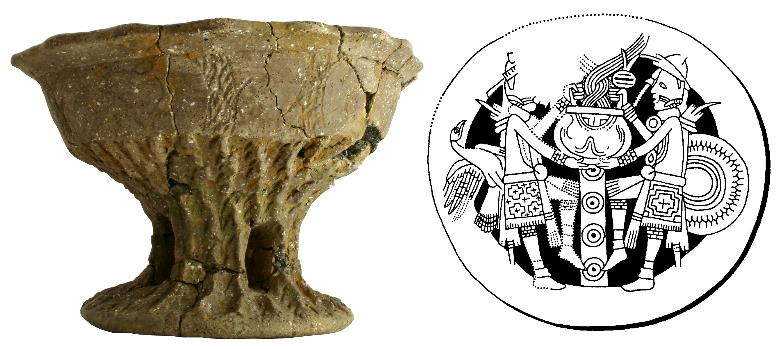
A bowl with a pedestal base from a burial at Pine Tree Mound beside a drawing of a shell gorget from Spiro in eastern Oklahoma, a key Mississippian moundbuilder site. The form of the bowl and the pot on top of a pole on the gorget are very similar. Both may show how important pottery vessels were in depicting a multilevel world.. |
|
The Engraved Scroll Motif and the Center of the WorldOne of the most widely recognized decorations on engraved vessels at Caddo sites near Pine Tree Mound is what archeologists call the scroll motif. The structure of this motif, like the dance ground on the Spiro and Roden site gorgets, is symbolic of the sacred center of the world. This motif has many variations, but uniting all of them is the four-part structure implicit in the rotational symmetry of the motif around a central element. This symmetry solidifies the motif’s connection to a symbolic representation of the dance ground and multilevel world with sacred center and four quarters. The central circle element, common within some scrolls, is a likely analog for the Caddo dance ground, and the space often left empty in the center of the circle may represent the sacred pole or axis mundi. In some cases, as on the Roden gorget, a cross is at the center of the circle. On bowls and bottles from the Pine Tree Mound site, this circle-with-cross element occurs only in the center of scrolls, never decorating the arms of scrolls. The two arms of the scroll, which meet at the central element, are comparable to the dancers circling the pole on the Roden gorget. The decorations within the scroll arms may identify who is dancing or at in what world level the dance is taking place. Decoration of the arms may be likened to the decoration found on the dancers on the Spiro and Roden gorgets. All the various decorative elements and their positions are part of the story the potter was trying to tell. The Feathered ScrollOne decorative element that may be a marker of a particular world level is called the pendant triangle. It appears most often in a secondary position in the arms of scrolls and other motifs and was made by repeatedly incising or engraving a small triangle along an engraved line, with the point of the triangle facing away or hanging down from the line. By shifting one’s focus away from the pendant triangle itself to what surrounds it, it is possible to see the scroll arms as having scalloped edges. A similar kind of scalloped edge is found on the wings of the Birdman in Mississippian iconography and on shell cups from the Spiro site. Reilly points out that feathers are depicted in different ways on the shell cups and that scalloping appears to be a particular kind of feather, that is, the downy feathers associated with the upper part of the inner wing. Hence, a scroll with pendant triangles on pottery can be viewed as representing a downy feathered scroll and, as on the Birdman, a connection with the upper world. Feathers are known to have been important symbolically for the historic Caddo. Griffith reports that the wing of an eagle was used in divination ceremonies to carry prayers to Ayo-Caddi-Aymay, the Great Spirit who resides in the upper world. Further, early Spanish reports indicate that the badge of a Caddo healer, or cona, was a feathered headdress and snakeskin necklace. Potters also expressed feathering by sculpting the clay. For instance, 13 bowls from the graves have scalloped rims. They made a scalloped rim by adding clay to the lip and shaping it into a series of rounded projections that fringed the mouth of the vessel. Scalloping the rim of a bowl would reinforce the idea that its rim belonged with the upper world. Six bowls have both scalloped rims and scroll motifs, but none of these scrolls have pendant triangles. Thus, it appears potters denoted feathering by one means or another, but not both. |
|
Serpent ScrollsIf using pendant triangles or feathering places the action or actor of a scroll motif in the upper world, then what other decorative elements may indicate connections to the lower world? Common secondary elements found in scrolls that may fill this role are bars, simple circles, and crosshatching. Many of the serpents or creatures with serpent-like attributes on the Spiro shell cups have body markings that are bars, chevrons, diamonds, circles, curls, and crosshatching, or combinations of these elements. While not exactly the same, the bars, circles, and crosshatching as secondary elements in the arms of scrolls are comparable. Further underscoring the importance of the serpent in Caddo cosmology are a number of bottles with representational rattlesnake motifs with body markings of crosshatching and chevrons that have been found at sites mainly in the Big Cypress Creek and middle Sabine River drainages of northeast Texas. These serpents are considered to be associated with the canebrake rattlesnake. The Great SerpentA powerful being in Mississippian iconography is known as the Great Serpent, Horned Serpent, or Piasa. This being ruled the lower world, but it was a mixed power that could work for ill or good in relation to humans. Its ability to act in the world of everyday life is symbolized by the combination of various animals, most notably bird and snake, to form the body of the serpent. Thus, when wings or feathers are placed on snake-like elements within a ceramic motif, the design may represent the Great Serpent and signify its manifestation in the visible night sky. There are many examples of composite snake-bird figures on shell cups from the Spiro site. One example shows these figures in four-fold rotational symmetry around a cross-in-circle central element similar to designs on some bowls from Pine Tree Mound. Some vessels have pendant triangles indicating feathering combined with snake elements such as crosshatching, chevrons, and bars. One bowl neatly combines both elements and full motifs indicating serpents and birds. Its body has concentric circles with pendant triangles forming scalloped edges suggesting feathering. Above the feathered circles on the tall rim is a straight scroll with SZ central elements and arms containing bars and crosshatching, all indicative of serpents. Above the serpent scroll, the lip of the vessel is scalloped, again suggesting feathering. |
|
|
|
|
Connections and AmbiguitiesThe comparison of Ripley Engraved vessels and vessel motifs from this site to Mississippian iconography demonstrates a deep connection between the Pine Tree Mound people and other groups. And it attempts to tie that connection to how the Pine Tree people structured their lives. Though the vessels discussed come from graves dating to 1400 to 1525, dating from the Pine Tree village areas suggest that occupation at the site continued into the 1700s. Yet, late Caddo ceramic types, such as Natchitoches Engraved, are all but invisible in the village ceramic assemblage. Did Ripley Engraved vessels continue to be produced into the protohistoric period? The ambiguities in the village vessel assemblage from Pine Tree provide no clear answers. That ambiguity itself is suggestive of disruption. Just six miles south of the Pine Tree Mound site in the same drainage there are several sites associated with the historic Kinsloe Phase that have burials with Natchitoches vessels and many artifacts of European origin. Ripley Engraved vessels are not in many of those graves. Motifs associated with Natchitoches vessels do have strong similarities to the Ripley Engraved motifs. Clearly, it is possible that, though the pottery may have changed, the message continued. |
|
